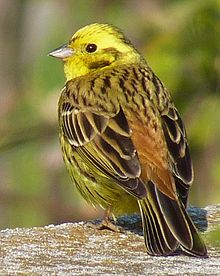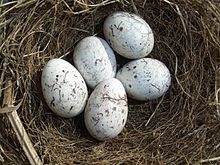Goldhammer
| Goldhammer | ||||||||||||
|---|---|---|---|---|---|---|---|---|---|---|---|---|

Male goldenhammer ( Emberiza citrinella ) |
||||||||||||
| Systematics | ||||||||||||
|
||||||||||||
| Scientific name | ||||||||||||
| Emberiza citrinella | ||||||||||||
| Linnaeus , 1758 |
The Yellowhammer ( Emberiza citrinella ) is a bird art from the family of the buntings (Emberizidae). It is the most common bunting in Europe and one of the characteristic breeding birds of the field marrow . Outside of the breeding season , larger troops sometimes form, which gather at favorable feeding grounds on the edge of villages or at pheasant and partridge pits. During the breeding season, however, the goldhammer is strictly territorial.
The IUCN classifies the goldhammer as not endangered ( least concern ). In the 2015 Red List of Breeding Birds in Germany, the species is on the pre-warning list. The goldhammer was bird of the year 1999 in Germany and 2002 in Switzerland.
description
The golden hammer reaches a body length of 16 to 17 centimeters and weighs 25 to 30 grams. The males wear a splendid yellow dress during the breeding season , they then have a bright yellow head with a few brownish stripes, a yellow underside with a reddish breast and brownish-gray elytra. The top of the body is brown with darker longitudinal stripes, the rump is cinnamon brown. The tail is dark, the white outer edge is noticeable in flight. The females are more inconspicuously green-brown in color, but still with yellow tendencies on the throat and underside. In the plain dress , the males resemble the females.
Newly hatched nestlings of the goldenhammer have long, dark gray downs on the head and body. Her throat and tongue are pink, but the whitish-pink edges and tips of the tongue stand out strikingly. The beak ridges are yellowish white.
The golden hammer can be distinguished from the similar looking bunting by its cinnamon-brown rump.
singing
The calls of the golden hammer can be heard very often. They are onomatopoeic with tsr , zik or zrk . The singing, on the other hand, consists of a series of short introductory notes and a long final section. Based on the small pause between the "Ti-ti-ti-ti-ti-ti" and the "Tüüüüüh", you can see the approximate age of the goldhammer. This pause is short for young birds. For the older of this type, correspondingly longer. In rare cases the goldhammer adds a little night note to this song, similar to a short whistle. On the other hand, the "Tüüüüüh" is always not heard when the goldhammer feels disturbed.
In Central Europe, goldenhamers are the only birds that still sing on warm days in midsummer. The singing is performed from an elevated position such as a bush or tree top or a stake.
Distribution area and habitat
The distribution area of the goldhammer extends from central Scandinavia to northern Spain , southern Italy, Greece and the Ukraine. In an easterly direction, their range extends from Ireland to far into Asia. European goldhamers were introduced to New Zealand in the 19th century and have successfully established themselves there.
The goldenhammer is a resident bird except for the outer areas of its range . Wintering birds can be found in Spain, Italy, the Balkans, Turkey and northern Israel, among others. They very rarely winter in Gibraltar, Malta and Sicily. As wanderers, they occasionally reach northern Morocco during the winter months.
Goldammers live in the open cultivated landscape with trees, hedges and bushes. In winter, they move around in large, mixed groups looking for any remaining seeds in fields.
nutrition
Adult goldenhamers mostly eat seeds, but the nestling diet is dominated by invertebrates, especially spiders , beetles , springtails , hymenoptera , butterfly larvae and grasshoppers , but also includes semi-ripe grains. Goldammers prefer to look for food in the early morning and evening hours, usually in small groups.
Reproduction
The breeding period of the goldenhammer begins in Central Europe from mid-April at the earliest and ends at the beginning of August at the latest. Goldammers raise two to three annual broods. They breed in open, mostly dry terrain, which has hedges, bushes and field trees . The nest is usually built on the ground in dense vegetation on the edge of hedges, embankments and under bushes.
Goldammers build their bowl nests on the ground or at least near the ground. The female lays three to five eggs. The eggs are spindle-shaped with a smooth, slightly shiny shell. The color is white to slightly bluish, grayish or brownish, and usually has delicate purple-gray and some strong black or dark brown scribbles and lines. The eggs are laid one day apart and the incubation period is 11 to 14 days. Only the female parent bird breeds, which is occasionally fed by the male at the nest. The nestling period is 9 to 14 days. After hatching, the nestlings are first hovered by the female , while the male brings in food which it hands over to the female.
Duration
In the 1990s there were around 2 million breeding pairs of goldhamers in Germany. However, the stocks are declining.
According to new data, the IUCN assumes a total population of 35–62 million goldhamers, which is why the bird is classified as “not endangered”.
Philatelic
With the Inception 2 May 2019 which gives German Post AG in the series Europe - Native birds a postage stamp in the denomination out of 70 euro cents. The design comes from nexd – new experience design from Düsseldorf.
Others
The singing of the goldhammer is a very characteristic, somewhat metallic sounding "Ti-ti-ti-ti-ti-ti-üüüüüüh", which is sometimes also referred to in the vernacular as "How how how did I do you liiiiieeeeb". The goldhammer is popularly known under the names Hämmerling, Ämmerling, Emmerling, Ammeritz, Gelbling, Gilberitz, yellow goose or Bauernkanari. In lëtzebuergesch she is called Gielemännchen.
literature
- Einhard Bezzel: birds. BLV Verlagsgesellschaft, Munich 1996, ISBN 3-405-14736-0 .
- C. Hilary Fry , Stuart Keith (Eds.): The Birds of Africa. Volume VII. Christopher Helm, London 2004, ISBN 0-7136-6531-9 .
- Collin Harrison, Peter Castell: Fledglings, Eggs and Nests of Birds in Europe, North Africa and the Middle East. Aula Verlag, Wiebelsheim 2004, ISBN 3-89104-685-5 .
Web links
- Emberiza citrinella in the endangered Red List species the IUCN 2008. Posted by: BirdLife International, 2008. Accessed January 2 of 2009.
- Goldhammer feathers
Individual evidence
- ^ E. Bezzel: Birds. 1996, p. 521.
- ↑ Christoph Grüneberg, Hans-Günther Bauer, Heiko Haupt, Ommo Hüppop, Torsten Ryslavy, Peter Südbeck: Red List of Germany's Breeding Birds , 5 version . In: German Council for Bird Protection (Hrsg.): Reports on bird protection . tape 52 , November 30, 2015.
- ↑ C. Harrison, P. Castell: Fledglings, eggs and nests of birds in Europe, North Africa and the Middle East. 2004, p. 441.
- ^ E. Bezzel: Birds. 1996, p. 520.
- ↑ CH Fry, S. Keith (Ed.): The Birds of Africa - Volume VII. 2004, p. 589.
- ^ JD Wilson, R. Taylor, LB Muirhead: Field use by farmland birds in winter: an analysis of field type preferences using resampling methods . In: Bird Study . tape 43 , no. 3 , November 1996, pp. 320-332 .
- ↑ C. Stoate, SJ Moreby, J. Szczur: Breeding ecology of farmland Yellowhammers Emberiza citrinella . In: Bird Study . tape 45 , 1998, pp. 109-121 .
- ↑ C. Harrison, P. Castell: Fledglings, eggs and nests of birds in Europe, North Africa and the Middle East. 2004, p. 442.





